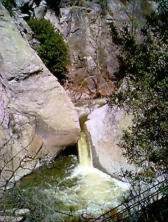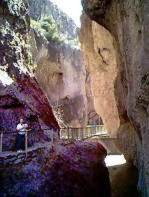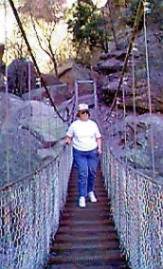Catwalk of
Whitewater Canyon
Gila
National Forest
Silver City,
NM.
March 25, 2001
Our second adventure, in Silver City, was some 50 miles
north. We were looking for the Catwalk of Whitewater Canyon. We
found it just outside Glenwood along US 180 in the Gila National
Forest. So the legend goes, Whitewater Canyon was the home of the
Apaches, known locally as either Chiricahau (Cheer-a-ka-wa),
Mogollones (Mug-ie-owns), or Gila (Heela) from sometime in the
1500s to the death of their last great leaders, Geronimo and
Victorio in the late 1800s. As a result of the Indian wars, Fort
Bayard was established nearby. One day, while on patrol into the
Whitewater Canyon, James C. Cooney found both gold and silver
veins in
second adventure, in Silver City, was some 50 miles
north. We were looking for the Catwalk of Whitewater Canyon. We
found it just outside Glenwood along US 180 in the Gila National
Forest. So the legend goes, Whitewater Canyon was the home of the
Apaches, known locally as either Chiricahau (Cheer-a-ka-wa),
Mogollones (Mug-ie-owns), or Gila (Heela) from sometime in the
1500s to the death of their last great leaders, Geronimo and
Victorio in the late 1800s. As a result of the Indian wars, Fort
Bayard was established nearby. One day, while on patrol into the
Whitewater Canyon, James C. Cooney found both gold and silver
veins in  the high country. He waited until
discharged before gathering a mining party and returning to stake
his claim in 1876, and the gold rush was on. One of those in the
party was John Lambert who would later find rich gold deposits in
the Whitewater Canyon leading to the famous Confidence Mine.
Although Cooney would not see the benefit of his discovery, he
was killed in an Apache raid 4 years later, the land would open
up to prospecting with several good strikes discovered in the
Canyon. Cooney's brother and friends carved a tomb into a giant
bolder in the Canyon and sealed it with ore from his mine. It can
still be seen today in Mineral Creek north of the Canyon. By 1893
there were 13 working mines in the area and John Graham saw an
opportunity. He built the Graham mill and the mining town of
Graham sprung up around him. It is here that the story of the
"catwalk" begins. The mill was operated by electricity
and along with the some
the high country. He waited until
discharged before gathering a mining party and returning to stake
his claim in 1876, and the gold rush was on. One of those in the
party was John Lambert who would later find rich gold deposits in
the Whitewater Canyon leading to the famous Confidence Mine.
Although Cooney would not see the benefit of his discovery, he
was killed in an Apache raid 4 years later, the land would open
up to prospecting with several good strikes discovered in the
Canyon. Cooney's brother and friends carved a tomb into a giant
bolder in the Canyon and sealed it with ore from his mine. It can
still be seen today in Mineral Creek north of the Canyon. By 1893
there were 13 working mines in the area and John Graham saw an
opportunity. He built the Graham mill and the mining town of
Graham sprung up around him. It is here that the story of the
"catwalk" begins. The mill was operated by electricity
and along with the some 200 people, now inhabiting the town,
needed a fairly large amount of water to maintain operations.
That was no problem in the spring and fall, but as winter came
on, the river dried up at the mill site, although it ran
constantly at upper elevations. The water needed by the town was
provided by construction of a 4-inch pipeline reaching about 3
miles up the canyon. The first line was laid in 1893 and followed
the west side of the canyon. It was packed in sawdust and encased
in wood to prevent freezing. By 1897, a new 18-inch line was laid
next to the 4-inch one. Construction of the water lines was an
engineering feat. Brace holes were drilled into the solid rock
walls, sometimes 20 feet above the canyon floor, to hold timbers
and iron bars that supported the small water line along its
meandering course. Some of the
200 people, now inhabiting the town,
needed a fairly large amount of water to maintain operations.
That was no problem in the spring and fall, but as winter came
on, the river dried up at the mill site, although it ran
constantly at upper elevations. The water needed by the town was
provided by construction of a 4-inch pipeline reaching about 3
miles up the canyon. The first line was laid in 1893 and followed
the west side of the canyon. It was packed in sawdust and encased
in wood to prevent freezing. By 1897, a new 18-inch line was laid
next to the 4-inch one. Construction of the water lines was an
engineering feat. Brace holes were drilled into the solid rock
walls, sometimes 20 feet above the canyon floor, to hold timbers
and iron bars that supported the small water line along its
meandering course. Some of the  original 18-inch pipe support one
side of the present day catwalk. Old records show that the large
iron water line was in constant need of maintenance. Workmen who
had to walk the line to repair damage dubbed it the
"catwalk". Despite the large investment of time and
money, the Graham Mill was never highly successful. Periodic
episodes of flooding and alleged mismanagement kept the mill from
flourishing. It was finally closed in 1913. For the next 17
years, few visitors saw the awesome views along the canyon walls,
then in 1930 the Civilian Conservation Corps was assigned the
task of rebuilding the Catwalk as a recreation attraction for the
Gila national Forest. It remained open until 1961 when the
present
original 18-inch pipe support one
side of the present day catwalk. Old records show that the large
iron water line was in constant need of maintenance. Workmen who
had to walk the line to repair damage dubbed it the
"catwalk". Despite the large investment of time and
money, the Graham Mill was never highly successful. Periodic
episodes of flooding and alleged mismanagement kept the mill from
flourishing. It was finally closed in 1913. For the next 17
years, few visitors saw the awesome views along the canyon walls,
then in 1930 the Civilian Conservation Corps was assigned the
task of rebuilding the Catwalk as a recreation attraction for the
Gila national Forest. It remained open until 1961 when the
present  metal Catwalk was constructed by the
Forest Service. In 1978, the trail was extended to the
convergence of the Whitewater and the South Fork rivers, a
distance of 1.1 miles, ending in an exciting swing cable
suspension bridge over the Whitewater River. The 800 foot climb
is aggressive with many parts of the trail presenting small rocky
crags in the pathway. Careful attention to where we placed our
feet was required. The actual "Catwalk" is only a
couple of hundred feet long and is near the beginning of the
trail. There are several steel girder bridges with wire mesh
flooring to cross but all are quite stable. The water is cold and
fast and on our trip was running all the way to the bottom. In
many places the path is less the two feet across with sheer rock
facing on one side and a drop off on the other. We kept an eye on
approaching traffic and would find an area of expanded trail to
stand off to the side, allowing others to pass. The terrain is
fascinating, rugged and beautiful. It is well worth the trip
which took us at a very slow climbing speed, a little over two
hours for the round trip.
metal Catwalk was constructed by the
Forest Service. In 1978, the trail was extended to the
convergence of the Whitewater and the South Fork rivers, a
distance of 1.1 miles, ending in an exciting swing cable
suspension bridge over the Whitewater River. The 800 foot climb
is aggressive with many parts of the trail presenting small rocky
crags in the pathway. Careful attention to where we placed our
feet was required. The actual "Catwalk" is only a
couple of hundred feet long and is near the beginning of the
trail. There are several steel girder bridges with wire mesh
flooring to cross but all are quite stable. The water is cold and
fast and on our trip was running all the way to the bottom. In
many places the path is less the two feet across with sheer rock
facing on one side and a drop off on the other. We kept an eye on
approaching traffic and would find an area of expanded trail to
stand off to the side, allowing others to pass. The terrain is
fascinating, rugged and beautiful. It is well worth the trip
which took us at a very slow climbing speed, a little over two
hours for the round trip.
Good Luck! Have Fun! and Stay Safe!
Laura